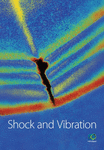Wind Load and Structural Parameters Estimation from Incomplete Measurements
Abstract
The extended minimum variance unbiased estimation approach can be used for joint state/parameter/input estimation based on the measured structural responses. However, it is necessary to measure the structural displacement and acceleration responses at each story for the simultaneous identification of structural parameters and unknown wind load. A novel method of identifying structural state, parameters, and unknown wind load from incomplete measurements is proposed. The estimation is performed in a modal extended minimum variance unbiased manner, based on incomplete measurements of wind-induced structural displacement and acceleration responses. The feasibility and accuracy of the proposed method are numerically validated by identifying the wind load and structural parameters on a ten-story shear building structure with incomplete measurements. The effects of crucial factors, including sampling duration and the number of measurements, are discussed. Furthermore, the practical application of the developed inverse method is evaluated based on wind tunnel testing results of a 234 m tall building structure. The results indicate that the structural state, parameters, and unknown wind load can be identified accurately using the proposed approach.
1. Introduction
Wind load is one of the main loads during the design stage of tall buildings [1, 2]. Studies show that the wind load on a tall building varies depending on the terrain condition, the shape of the building, and the surrounding buildings [3]. In most design processes, wind load is calculated according to the design code [4, 5]. However, it is difficult to calculate the time histories of wind load based on design code as the wind load design code is determined based on statistical information. Wind tunnel tests and computational fluid dynamic simulations are currently used to determine the time-varying wind load on a given structure [6, 7]. However, neither of the methods can exactly reproduce the incident turbulence and the characteristic of the surrounding buildings. Field measurement is regarded as the most accurate way of obtaining the time-varying wind load on tall buildings. However, due to the limitation of the wind load measurement technique, real-time measurement of wind load is difficult by field measurement. Compared to wind load measurement, the measurement of wind-induced displacement and acceleration responses is easier to achieve and more accurate.
In recent years, a lot of force estimation methods have been developed [8–10]. Law et al. identified wind load on a 50 m guyed mast from structural responses by regularization of the identification equation [11]. Lu and Law proposed a method for identifying unknown load using sensitivity measures of the dynamic response with respect to the input load [12]. Liu and Shepard developed a dynamic force identification approach based on the enhanced least squares approach in the frequency domain [13]. Ma et al. presented a Kalman filter method with a recursive estimator to determine the unknown excitation [14, 15]. The aforementioned approaches require that the unknown load has been generally point load acting at a specific DOF. However, wind loads acting on a building structure vary with space and time, and the methods in previous works cannot directly be used for wind load identification of building structures.
To address the aforementioned issue, Hwang et al. proposed the Kalman filtering approach in modal domain to estimate modal loads on a structure using limited measured response [16, 17]. Zhi et al. developed the Kalman filtering method and proper orthogonal decomposition technique to estimate the modal wind load on tall buildings [18, 19]. In 2007, Gillijns and Moor proposed an approach for joint input-state estimation in discrete-time dynamic system based on minimum variance unbiased solution [20]. Lourens et al. applied the method to estimate structural responses and unknown inputs in both numerical and experimental studies [21]. This method requires no assumption or prior knowledge about the unknown inputs, and it can be used for wind load identification in the physical domain [22]. Unfortunately, the aforementioned wind load estimation approaches assumed that the structural parameters are known a priori. However, for actual building structures, the structural parameters are generally determined based on the finite element model and it is difficult to calculate structural parameters exactly due to the material aging and damage in the structures.
To solve this problem, Wan et al. proposed a method called EGDF which is an extension of the unbiased minimum variance estimation for coupled state/input/parameter identification for nonlinear systems in state space [23]. Song developed the joint input-state estimation technique for joint input-state-parameter estimation based on the unscented minimum variance unbiased (UMVU) estimation method [24]. However, both EGDF and UMVU methods require that it is necessary to measure the acceleration responses at the locations where unknown inputs are applied, i.e., complete acceleration measurements at all DOFs are requested for simultaneous estimation of wind load and unknown structural parameters.
A novel method of the modal extended unbiased minimum variance estimation for joint state/parameter/wind load estimation from incomplete measurements is proposed in this study. The proposed method is able to simultaneously estimate the wind loads and structural parameters without using complete acceleration measurements. Moreover, the data fusion of acceleration responses and interstory displacement responses is used to prevent the drifts of the identified displacements responses and wind loads. The content of this paper is organized as follows. In Section 2, the proposed method of the modal extended unbiased minimum variance estimator is derived and the necessary mathematical proofs are given. In Section 3, a numerical validation by identifying wind loads and structural parameters from incomplete measurements on a ten-story shear building structure is addressed. Moreover, the effects of key factors, including sampling duration and the number of measurements, are discussed. In Section 4, a synchronous multipressure scanning system wind tunnel test on a 234 m tall building structure is carried out to validate the proposed method. In order to simplify the calculation, an equivalent model is carried out for experiment validation. Finally, in Section 5, the discussion and conclusion are summarized.
2. Modal Extended Minimum Variance Unbiased Estimation
2.1. System Model
2.2. Eigenvalue and Eigenvector Sensitivity
2.3. Modal Extended Minimum Variance Unbiased Estimation
2.3.1. Time Update
2.3.2. Modal Wind Load Estimation
Therefore, can be obtained. This indicates that the estimated modal wind load is unbiased if and only if Sk+1 satisfies Sk+1Hk+1 = I.
Generally, , where c is a positive real number. This indicates that equation (34) does not satisfy homoscedasticity. Therefore, the estimator given in equation (36) is not the minimum variance estimation of modal wind load according to the Gauss–Markov theorem [30].
2.3.3. Measurement Update
3. Numerical Simulation
To verify the feasibility and accuracy of the proposed method, a ten-story shear building structure under wind load is considered. The mass coefficient of each floor is m = 105 kg, and the stiffness coefficient of each floor is k = 2.45 × 108 N/m The damping is assumed to be Rayleigh damping which is calculated as C = αM + βK with proportional coefficients of α = 0.557 and β = 0.0034. The corresponding damping ratio for the first two modes of vibration is approximate 5%.
The fluctuating wind speed is numerically simulated based on the autoregressive model method. The power spectral density is Davenport spectral. The vertical wind profile is taken as the power profile with an exponent of a = 0.22 and a reference height of zG = 10 m according to the Chinese National Load Code [32]. The mean wind speed at the reference height is 10 m/s. Figure 1 shows the simulated fluctuating wind speed on the fifth and tenth floors. Figure 2 shows the comparison of the power spectral density between the simulated fluctuating wind speed and the Davenport spectral on the fifth and tenth floors. Figure 2 shows that the simulated power spectral density matches very well with the Davenport spectral. The wind load acting on the building structure is calculated according to [22]. The air density is assumed to be ρ = 1.29 kg/m3. The drag coefficient is set to 1.3, and the orthogonal exposed wind area of each floor is set to 50 m2.
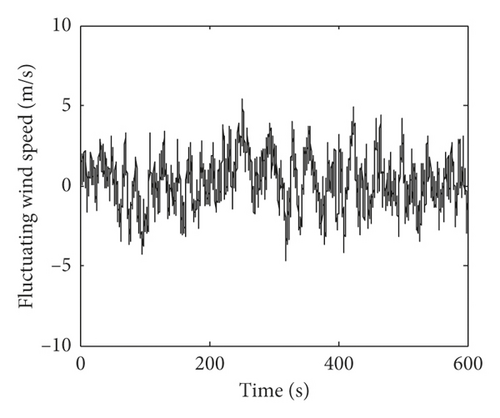
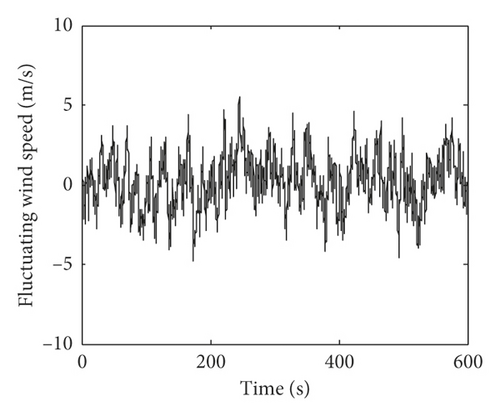
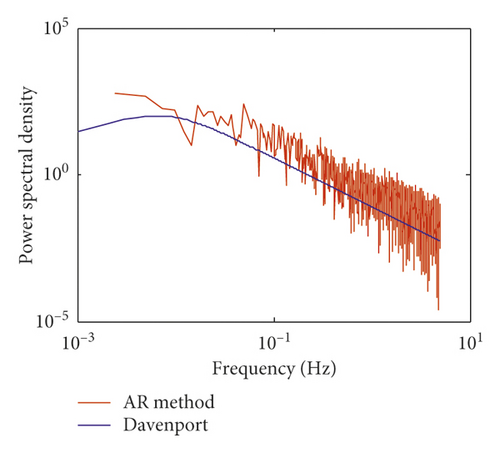

3.1. Joint State/Parameter/Wind Load Estimation Based on Incomplete Measurements
In this section, the interstory displacement and acceleration taken as the “measurements” are calculated based on the Newmark-β method and superimposed with 2% root mean square (RMS) white noise. Only seven sets of measurements including seven accelerations and seven interstory displacements are used for the estimation. The locations of the measurements are listed in Table 1. The unknown structural parameters are structural stiffness coefficients on each floor and the two Rayleigh damping coefficients. The initial value of the augmented state vector is , where k = [k1, k2, …, k9, k10]. The initial error covariance matrix of the augmented state vector is . The covariance matrix of process noise is Q = 10−2, and the covariance matrix of measurement noise is R = 10−1. Figure 3 shows the comparison of the estimated structural displacement responses with exact values on the fifth and tenth floors for time and frequency domains. Figure 4 shows the comparison of the estimated structural velocity responses with exact values on the fifth and tenth floors for time and frequency domains. The estimated curves coincide with the exact curves. This indicates that the proposed method is capable of identifying structural responses. Furthermore, two obvious peaks at 1.185 Hz and 3.527 Hz can be obtained in Figures 3 and 4. The two peaks correspond to the first two translational natural frequency of the building.
| Number of measurements | Location (floor) |
|---|---|
| 7 | 2, 3, 4, 5, 7, 9, 10 |

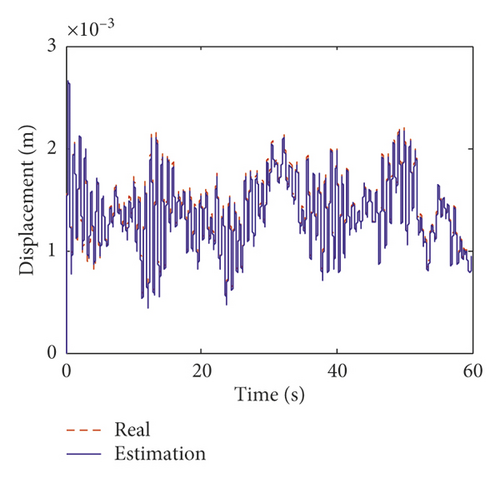
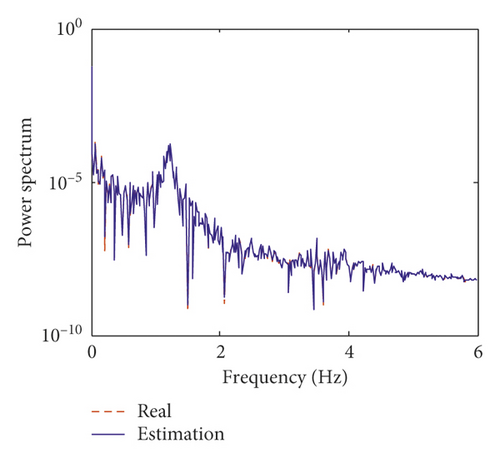
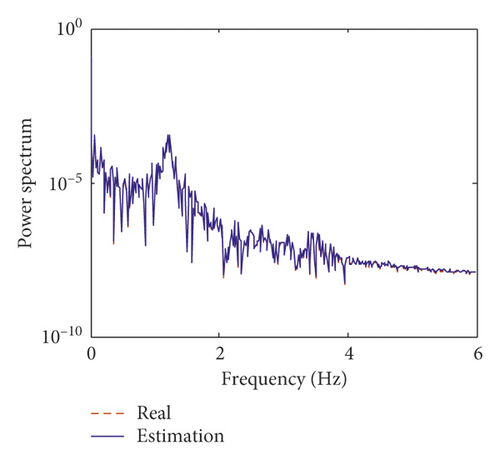
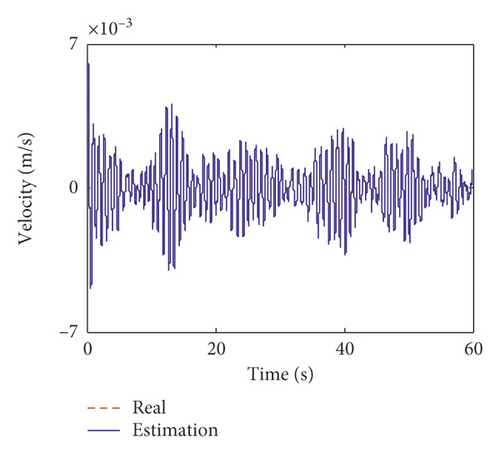


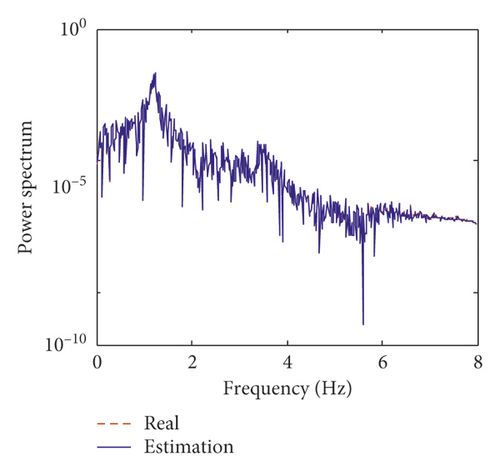
Moreover, based on the proposed method, the unknown wind load is identified using incomplete measurements. The identified wind load and the relative errors between the identified wind load and the exact one in percentage on the fifth and tenth floors of the numerical model are plotted in Figure 5. Figure 5 shows that the iteration process cannot converge immediately, but after approximately 8 s, the relative errors are well converged to less than 5%. Table 2 shows the mean errors and the RMS errors between the identified wind loads and the exact ones on each floor. From Table 2, the maximum mean errors and RMS errors of the identified wind loads are 4.12% and 4.56%, respectively. This means that the identified wind loads match the exact ones very well after iterative convergence.
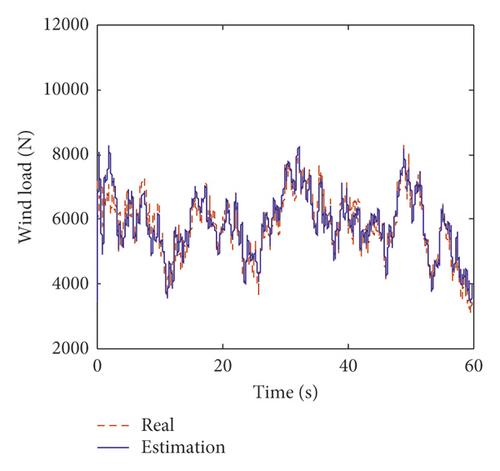
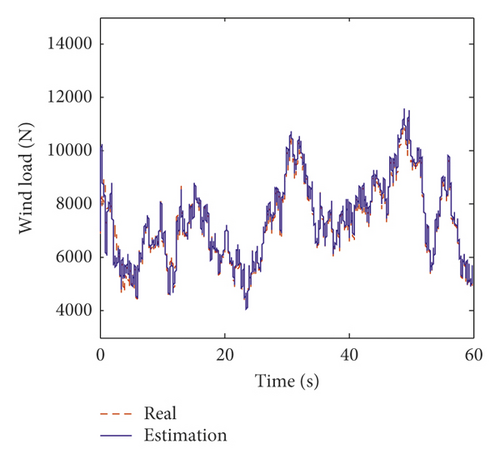
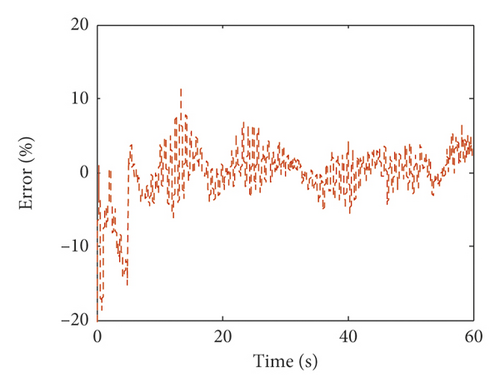
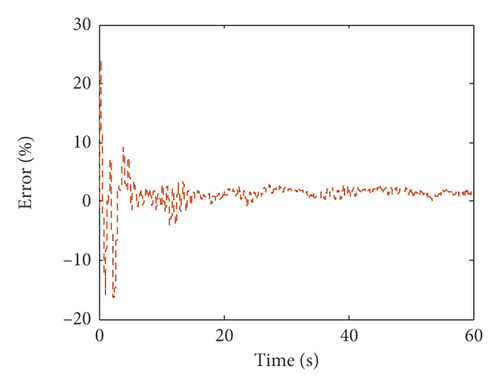
| Floor number | Mean error (%) | RMS error (%) | Floor number | Mean error (%) | RMS error (%) |
|---|---|---|---|---|---|
| 1 | 0.22 | 4.11 | 6 | 4.09 | 4.56 |
| 2 | 3.88 | 4.17 | 7 | 3.68 | 3.82 |
| 3 | 4.12 | 4.31 | 8 | 3.89 | 4.21 |
| 4 | 3.01 | 3.49 | 9 | 3.21 | 3.30 |
| 5 | 0.38 | 3.87 | 10 | 1.16 | 2.92 |
Figure 6 shows the estimated results of the fifth and tenth structural stiffness coefficients. It indicates that the stiffness coefficients can converge to the real value within 2 s. The estimation results of Rayleigh damping coefficients α and β are plotted in Figure 7. Compared to the stiffness coefficient, the damping coefficient converges slightly slower and can converge to a real value within approximately 5 s. Table 3 lists the estimated values and errors of the structural parameters. The maximum error for the stiffness coefficient is 4.30%. The estimated errors for the damping coefficients α and β are 4.25% and 4.24%, respectively. This indicates that the proposed method is capable of identifying the structural parameters with incomplete measurements.


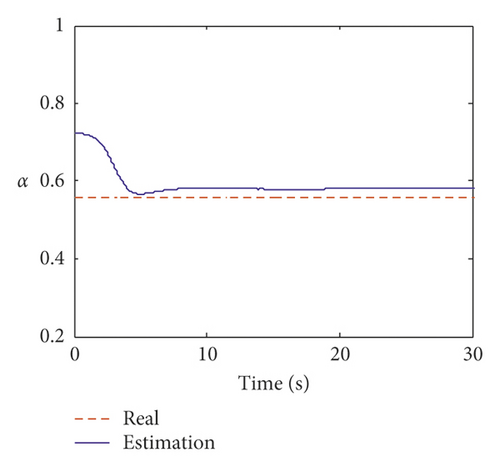
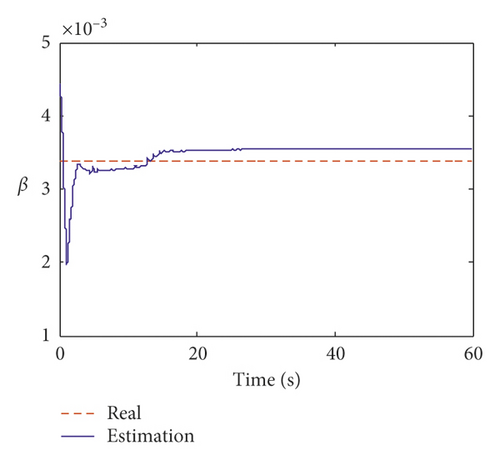
| Structural parameter | Estimated value | Error (%) | Structural parameter | Estimated value | Error (%) |
|---|---|---|---|---|---|
| k1 | 2.55 × 108 | 3.97 | k7 | 2.55 × 108 | 4.08 |
| k2 | 2.37 × 108 | 3.44 | k8 | 2.55 × 108 | 4.19 |
| k3 | 2.35 × 109 | 4.15 | k9 | 2.53 × 108 | 3.37 |
| k4 | 2.54 × 108 | 3.84 | k10 | 2.34 × 108 | 4.30 |
| k5 | 2.35 × 108 | 3.96 | α | 5.81 × 10−1 | 4.25 |
| k6 | 2.35 × 108 | 3.99 | β | 3.58 × 10−3 | 4.24 |
3.1.1. Effect of Sampling Duration
To investigate the stability of the proposed method, the effect of the sampling duration on wind load and structural parameter estimation is discussed. The number and location of measurements are the same as in Table 1. The total duration of the measurements is set to 1 s, 10 s, 30 s, and 60 s. Table 4 shows the RMS errors of the estimated wind load on each floor under different sampling durations. The estimated results of the structural parameters are given in Table 5. From Table 4, the maximum RMS errors of wind load under 1 s, 10 s, 30 s, and 60 s are 14.23%, 7.68%, 4.58%, and 4.55%, respectively. From Table 5, the maximum errors of the structural parameters under 1 s, 10 s, 30 s, and 60 s are 32.78%, 6.99%, 4.66%, and 4.25%, respectively. This indicates that the estimation errors decrease as the time duration increases. Table 5 shows that the estimation errors of the wind load and structural parameters are all less than 5% when the sampling duration reaches 30 s. Furthermore, comparing the estimated results between 30 s and 60 s shows that the estimation accuracy increases slightly. Therefore, considering the computational costs, the sampling duration of 30 s is adequate for this numerical simulation.
| Floor number | RMS error (%) | |||
|---|---|---|---|---|
| Duration: 1 s | Duration: 10 s | Duration: 30 s | Duration: 60 s | |
| 1 | 7.77 | 6.33 | 4.52 | 4.11 |
| 2 | 5.86 | 5.68 | 4.45 | 4.17 |
| 3 | 5.83 | 5.20 | 4.45 | 4.31 |
| 4 | 6.65 | 5.92 | 3.97 | 3.49 |
| 5 | 14.23 | 7.68 | 4.03 | 3.87 |
| 6 | 7.46 | 5.15 | 4.58 | 4.55 |
| 7 | 7.30 | 5.74 | 3.92 | 3.82 |
| 8 | 6.23 | 5.41 | 4.35 | 4.21 |
| 9 | 7.55 | 6.54 | 3.34 | 3.30 |
| 10 | 11.94 | 6.20 | 3.81 | 2.92 |
| Structural parameter | Duration: 1 s | Duration: 10 s | Duration: 30 s | Duration: 60 s | ||||
|---|---|---|---|---|---|---|---|---|
| Estimated value | Error (%) | Estimated value | Error (%) | Estimated value | Error (%) | Estimated value | Error (%) | |
| k1 | 2.59 × 108 | 5.86 | 2.57 × 108 | 4.98 | 2.55 × 108 | 4.12 | 2.55 × 108 | 3.97 |
| k2 | 2.33 × 108 | 4.89 | 2.36 × 108 | 3.55 | 2.37 × 108 | 3.45 | 2.37 × 108 | 3.44 |
| k3 | 2.36 × 108 | 3.76 | 2.37 × 108 | 3.39 | 2.35 × 108 | 4.20 | 2.35 × 108 | 4.15 |
| k4 | 2.56 × 108 | 4.55 | 2.55 × 108 | 4.14 | 2.55 × 108 | 4.15 | 2.54 × 108 | 3.84 |
| k5 | 2.59 × 108 | 5.61 | 2.57 × 108 | 4.84 | 2.35 × 108 | 4.01 | 2.35 × 108 | 3.96 |
| k6 | 2.26 × 108 | 7.62 | 2.28 × 108 | 6.99 | 2.35 × 108 | 4.02 | 2.35 × 108 | 3.99 |
| k7 | 2.56 × 108 | 4.41 | 2.55 × 108 | 4.08 | 2.55 × 108 | 4.09 | 2.55 × 108 | 4.08 |
| k8 | 2.56 × 108 | 4.35 | 2.55 × 108 | 4.21 | 2.55 × 108 | 4.21 | 2.55 × 108 | 4.19 |
| k9 | 2.55 × 108 | 4.06 | 2.53 × 108 | 3.36 | 2.53 × 108 | 3.40 | 2.53 × 108 | 3.37 |
| k10 | 2.28 × 108 | 6.97 | 2.29 × 108 | 6.53 | 2.34 × 108 | 4.52 | 2.34 × 108 | 4.3 |
| α | 0.740 | 32.78 | 0.575 | 3.28 | 0.581 | 4.66 | 0.581 | 4.25 |
| β | 0.00440 | 29.33 | 0.00325 | 4.37 | 0.00348 | 3.49 | 0.00348 | 2.24 |
3.1.2. Effect of the Number of Measurements
This section discusses the influence of the number of measurements for joint state/parameter/wind load estimation. The considered set of measurements is four to nine, and each set of measurements includes interstory displacement and acceleration responses. Table 6 shows the number of measurements and the corresponding locations.
| Number of measurements | Location (floor) |
|---|---|
| 9 | 1, 2, 3, 5, 6, 7, 8, 9, 10 |
| 8 | 1, 3, 4, 5, 6, 8, 9, 10 |
| 7 | 2, 3, 4, 5, 7, 9, 10 |
| 6 | 1, 2, 4, 6, 8, 10 |
| 5 | 2, 4, 6, 8, 10 |
| 4 | 1, 4, 6, 9 |
The time histories of the estimated wind loads on the fifth and tenth floors under different numbers of measurements are plotted in Figure 8. Figure 8 shows that the variation trends of the identified wind loads are identical to the exact ones. However, there is an obvious error between the estimated value and the exact one when the number of measurements is less than six. The RMS errors of the identified wind load on each floor under different numbers of measurements are listed in Table 7. Table 7 shows that as the number of measurements increases, the RMS error of the estimated wind load decreases. The maximum error under six, five, and four sets of measurements is 5.33%, 7.08%, and 10.78%, respectively. This indicates that the estimation error increases significantly when the number of measurements is less than six.
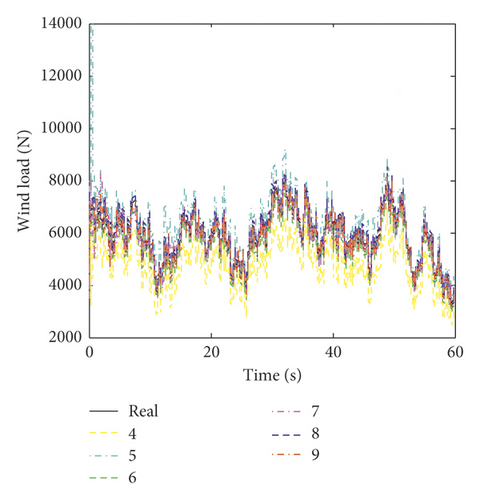
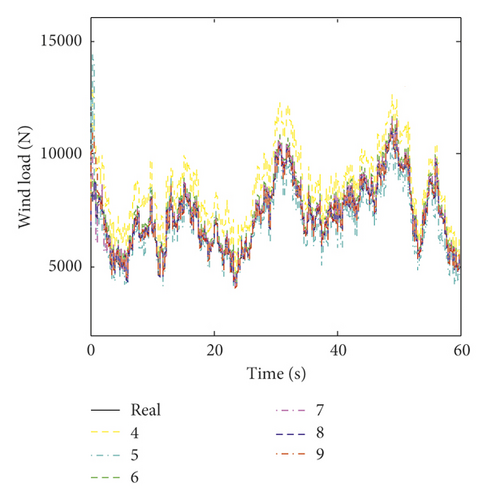
| Floor number | Nine measurements | Eight measurements | Seven measurements | Six measurements | Five measurements | Four measurements |
|---|---|---|---|---|---|---|
| 1 | 2.43 | 3.47 | 4.11 | 4.77 | 6.27 | 9.29 |
| 2 | 2.4 | 3.06 | 4.17 | 4.71 | 5.14 | 10.6 |
| 3 | 2.06 | 3.24 | 4.31 | 4.7 | 6.38 | 8.12 |
| 4 | 2.34 | 3.01 | 3.49 | 4.38 | 6.09 | 10.78 |
| 5 | 2.43 | 3.15 | 3.87 | 4.51 | 7.08 | 9.2 |
| 6 | 2.98 | 3.42 | 4.56 | 5.33 | 5.59 | 8.23 |
| 7 | 2.49 | 3.3 | 3.82 | 4.58 | 6.03 | 10.06 |
| 8 | 2.24 | 3.45 | 4.21 | 4.77 | 5.77 | 9.2 |
| 9 | 0.81 | 2.31 | 3.3 | 4.95 | 6.30 | 8.05 |
| 10 | 1.1 | 2.42 | 2.92 | 3.48 | 5.94 | 9.25 |
The time histories of the estimated errors of the fifth and tenth structural stiffness coefficients for different numbers of measurements are shown in Figure 9. Figure 9 shows that at the beginning of the iteration are some fluctuations. However, after approximately 2 s, the iteration converges to the true value. Figure 10 plots the estimated errors of damping coefficients α and β. Figure 10 shows that both α and β have a large fluctuation at the beginning of the iteration, and they converge to the true value after approximately 10 s under more than seven measurements. However, the estimation results fluctuate around the true value when the number of measurements is less than seven. This indicates that damping coefficients are sensitive to the number of measurements and fluctuate around the true value if the number of measurements is insufficient. Table 8 gives the estimation results of the structural parameters with the number of measurements (i.e., from 4 to 9). The maximum errors of the estimated parameters under four to nine measurements are 13.01%, 11.76%, 9.83%, 4.30%, 3.71%, and 3.63%, respectively. It indicates that as the number of measurements increases, the estimation accuracy of the structural parameters increases. The maximum errors of the structural stiffness coefficient and the damping coefficients α and β under six sets of measurements are 5.98%, 9.83%, and 5.33%, respectively. However, the estimation errors of each structural parameter are less than 5% under seven sets of measurements. The results indicate that, for this particular example, at least seven sets of measurements should be used.
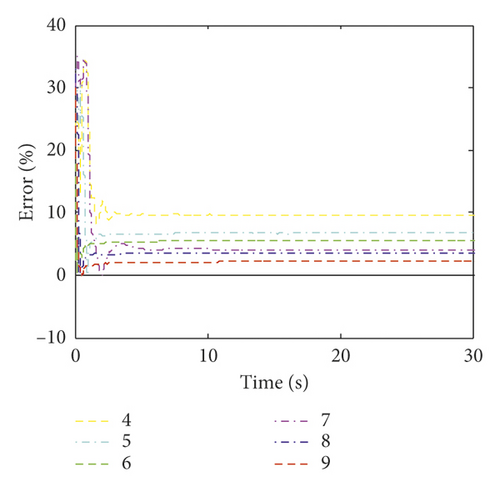
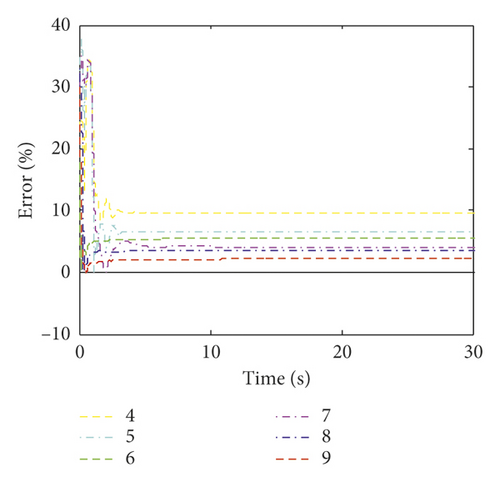
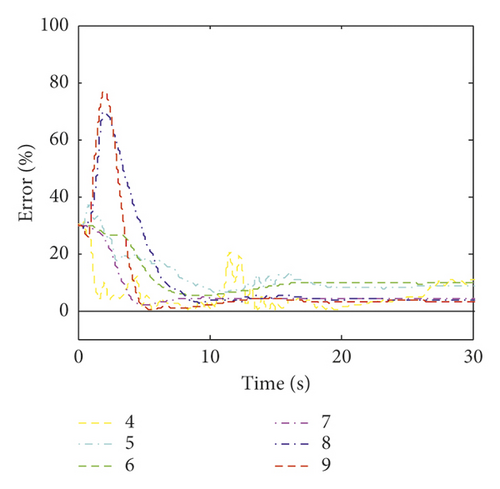
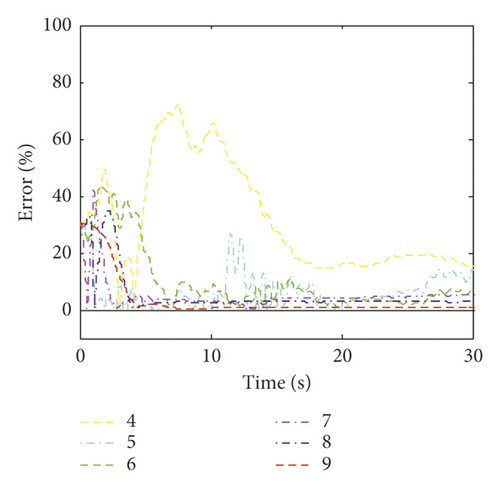
| Structural parameter | Nine measurements | Eight measurements | Seven measurements | Six measurements | Five measurements | Four measurements | ||||||
|---|---|---|---|---|---|---|---|---|---|---|---|---|
| Value (×108) | Error (%) | Value (×108) | Error (%) | Value (×108) | Error (%) | Value (×108) | Error (%) | Value (×108) | Error (%) | Value (×108) | Error (%) | |
| k1 | 2.52 | 2.81 | 2.37 | 3.38 | 2.55 | 3.97 | 2.35 | 4.12 | 2.61 | 6.52 | 2.68 | 9.51 |
| k2 | 2.39 | 2.56 | 2.52 | 2.88 | 2.37 | 3.44 | 2.55 | 4.02 | 2.60 | 6.28 | 2.68 | 9.48 |
| k3 | 2.40 | 2.03 | 2.37 | 3.12 | 2.35 | 4.15 | 2.34 | 4.31 | 2.58 | 5.45 | 2.21 | 9.62 |
| k4 | 2.40 | 1.97 | 2.53 | 3.24 | 2.54 | 3.84 | 2.30 | 5.98 | 2.61 | 6.44 | 2.22 | 9.26 |
| k5 | 2.51 | 2.35 | 2.53 | 3.44 | 2.35 | 3.96 | 2.59 | 5.65 | 2.28 | 6.74 | 2.69 | 9.64 |
| k6 | 2.51 | 2.26 | 2.38 | 2.76 | 2.35 | 3.99 | 2.57 | 5.07 | 2.29 | 6.39 | 2.70 | 10.08 |
| k7 | 2.38 | 2.86 | 2.37 | 3.42 | 2.55 | 4.08 | 2.57 | 4.94 | 2.30 | 6.27 | 2.68 | 9.25 |
| k8 | 2.39 | 2.28 | 2.52 | 2.98 | 2.55 | 4.19 | 2.32 | 5.43 | 2.62 | 6.74 | 2.71 | 10.46 |
| k9 | 2.49 | 1.50 | 2.51 | 2.49 | 2.53 | 3.37 | 2.55 | 4.25 | 2.29 | 6.73 | 2.67 | 9.18 |
| k10 | 2.50 | 2.12 | 2.53 | 3.40 | 2.34 | 4.30 | 2.58 | 5.43 | 2.29 | 6.62 | 2.69 | 9.61 |
| Α × 108 | 0.577 | 3.63 | 0.581 | 3.71 | 0.581 | 4.25 | 0.612 | 9.83 | 0.592 | 6.27 | 0.606 | 8.71 |
| β × 108 | 0.00342 | 0.76 | 0.0035 | 2.8 | 0.00348 | 2.24 | 0.00358 | 5.33 | 0.0038 | 11.76 | 0.00384 | 13.01 |
4. Validation with Wind Tunnel Tests
In order to verify the effectiveness of the proposed method in practical engineering application, a tall building with 58 floors is considered as an example in this study. The size of the building is 234 m (height) × 39 m (width) × 39 m (length). The synchronous multipressure scanning system wind tunnel test for simultaneous estimation of state, unknown structural parameters, and wind load was conducted in wind environment wind tunnel laboratory at Harbin Institute of Technology (Shenzhen), China. According to Chinese National Load Code (GB 50009-2012) [32], the site around the test building is taken as terrain C. The wind profile is regarded as power law with an exponent of 0.22. The length scale of this wind tunnel test is 1 : 300. Figure 11 shows the simulated profiles of mean wind speed and turbulence intensity.
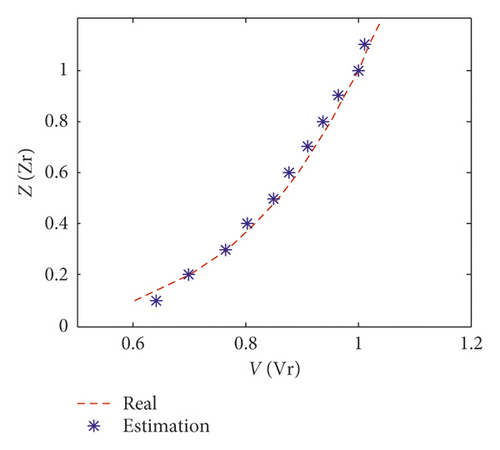
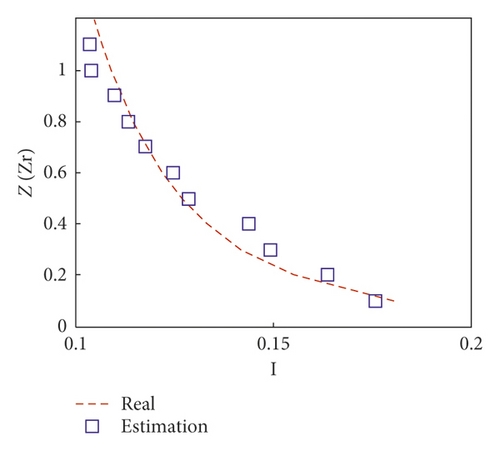
The model has the same length scale with that of wind field simulation, i.e., 1 : 300. The size of the model is 780 mm (height) × 130 mm (width) × 130 mm (length), as shown in Figure 12. In this wind tunnel test, wind direction was defined as an angle θd from 0° to 360° with increments of 15°, as shown in Figure 13. The total number of the pressure taps installed on the building was 441 with 98 on each side surface and 49 on top surface. The pressure data were collected using an microelectronic pressure scanner system made by PSI. The data sampling frequency was 330 Hz, and the sampling length was 120 s. The wind speed at the top of the model with a 10-year return period is 39.6 m/s based on Chinese National Load Code [32].
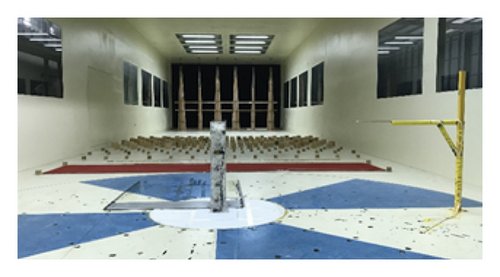

4.1. Equivalent Model of the Tall Building
| Number of modes | 1 | 2 | 3 | 4 | 5 |
|---|---|---|---|---|---|
| Displacement | 99.458 | 99.963 | 99.994 | 99.999 | 99.999 |
| Velocity | 98.068 | 99.673 | 99.898 | 99.963 | 99.989 |
| Acceleration | 85.276 | 94.096 | 96.825 | 98.396 | 99.369 |
| Floor number | 1 | 2 | 3 | 4 | 5 |
|---|---|---|---|---|---|
| Me | 3.62 × 107 | 2.38 × 107 | 2.30 × 107 | 2.11 × 107 | 1.16 × 107 |
| Ke | 9.53 × 108 | 2.52 × 108 | 2.30 × 108 | 2.04 × 108 | 1.74 × 108 |
| Modal order | 1 | 2 | 3 | 4 | 5 |
|---|---|---|---|---|---|
| Real value | 0.19 | 0.49 | 0.77 | 1.07 | 1.35 |
| Simplified model | 0.19 | 0.51 | 0.76 | 0.90 | 1.00 |
| Error (%) | 2.48 | 4.16 | 2.34 | 15.50 | 26.10 |
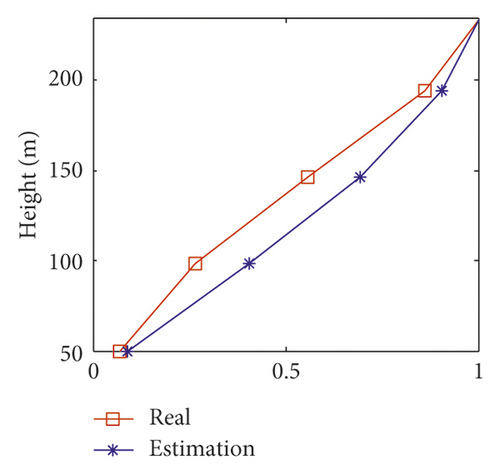
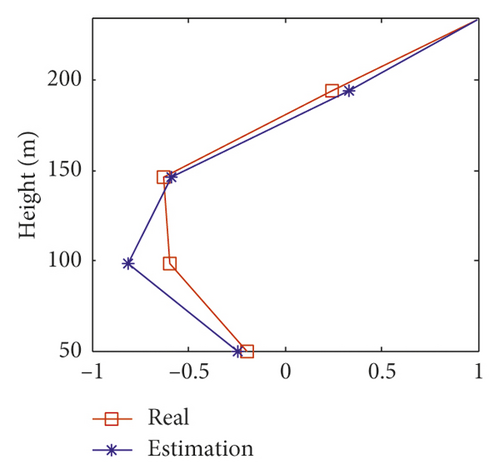
4.2. Wind Load and Structural Parameters Estimation
The wind-induced responses of the tall building cannot be measured directly from the pressure measurement on a rigid model in the wind tunnel test. Hence, wind-induced responses including displacement, velocity, and acceleration responses are calculated based on the wind tunnel test results and the structural dynamic properties of the prototype building structure using the Newmark-β method. In order to validate the feasibility of the proposed method, only three sets of measurements including structural interstory displacement responses and acceleration responses on the 12th, 36th, and 58th floors are taken as the “measurements.” The unknown parameters are five stiffness coefficients and two Rayleigh damping coefficients of the equivalent model. The unknown excitations are equivalent wind load on the equivalent model. The initial value of the state vector is . The initial error covariance matrix is . The covariance matrices of process noise and measurement noise are 10−2 and 10−1, respectively.
Figures 15 and 16 show the estimation results of structural displacement responses and velocity responses on the 24th and 58th floors, respectively. It can be found that the time histories of the estimated responses match very well with the exact responses. Meanwhile, the power spectrum of the estimated responses is found to agree well with those of the exact responses except slight differences in high frequency components (>0.8 Hz) of the responses on the 24th floor. This is mainly because (1) there is no measurement information on the 24th floor, and the estimation results on the 24th floor is obtained from modal transformation and (2) the errors of the modal information between the equivalent model and prototype model are large in higher modes (i.e., the fourth and fifth modes).
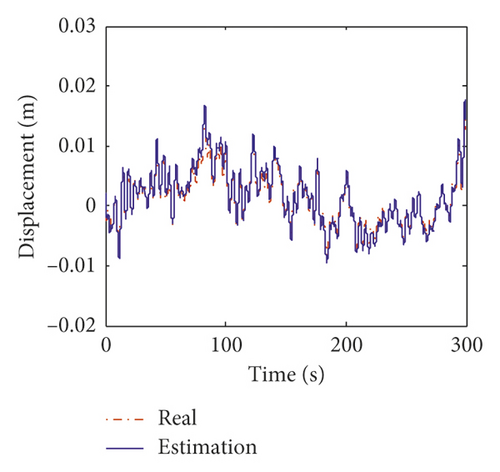
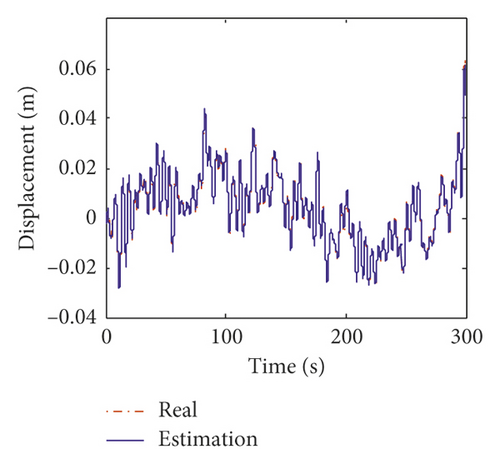

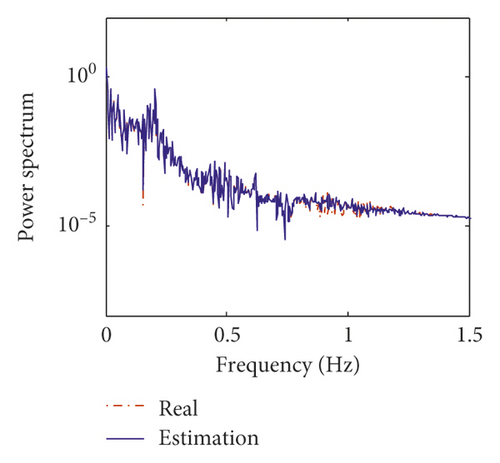
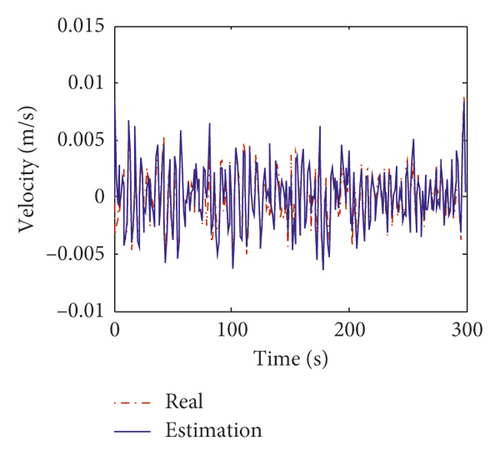
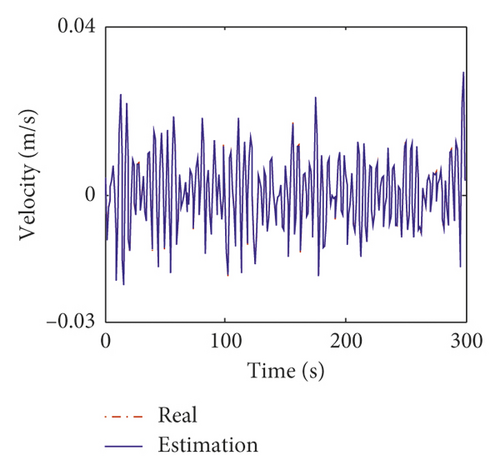
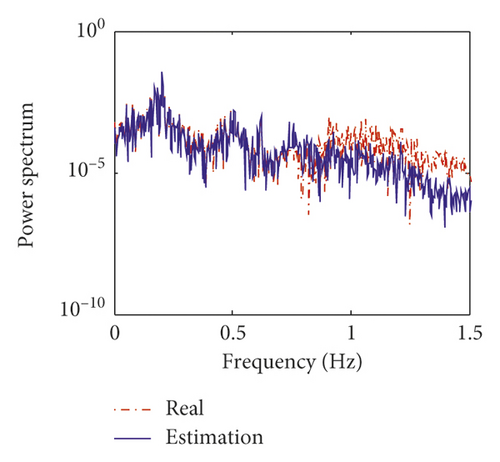
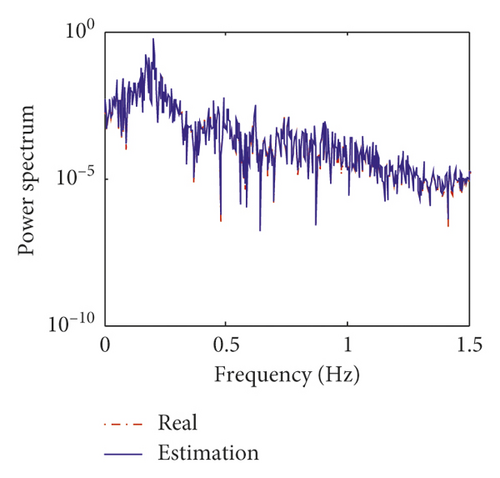
Displayed in Figure 17 is the comparison of the time histories of the equivalent wind load between the exact values and estimated values on the 24th floor and 58th floor. It can be observed that the estimated curves agree very well with the exact ones. The estimation errors of the equivalent wind load are listed in Table 12. From Table 12, the maximum mean error and RMS error of the identified wind load are 4.95% and 5.89%. Figure 18 shows the estimation results of the equivalent stiffness coefficients. It indicates that the stiffness coefficients can converge to the real value within 5 s. The estimation results of damping coefficients are shown in Figure 19, and it can be found that the damping coefficients can converge to the real value within about 10 s. The estimated values and errors of structural parameters are given in Table 13. The errors of the stiffness coefficient are less than 5% except that on the 12th floor. The errors of the damping coefficient α and β are 3.8% and 2.11%, respectively. The comparison results indicate that the inverse method presented in this study is applicable to the practical engineering.
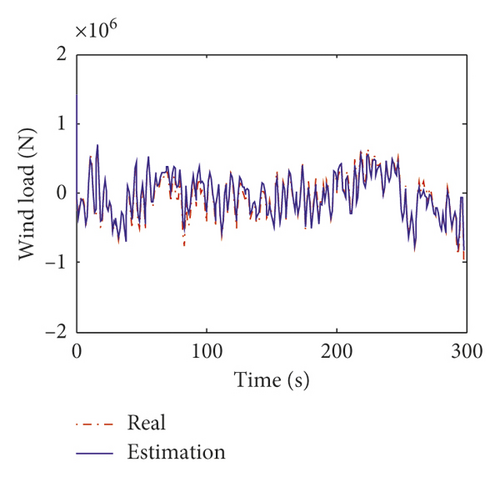
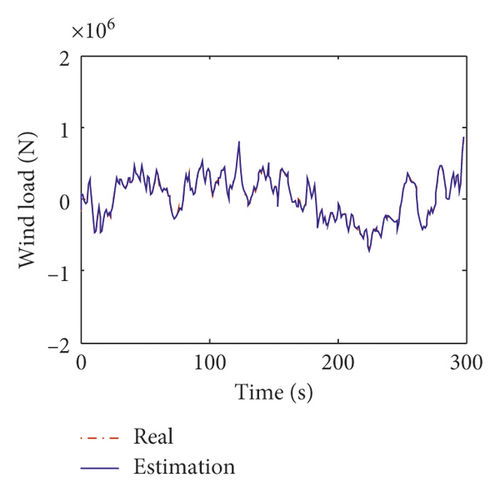
| Floor number | 12 | 24 | 36 | 48 | 58 |
|---|---|---|---|---|---|
| Mean value | 4.95 | 4.59 | −4.87 | 4.29 | 4.93 |
| RMS | 1.63 | 3.85 | 5.27 | 5.55 | 5.89 |
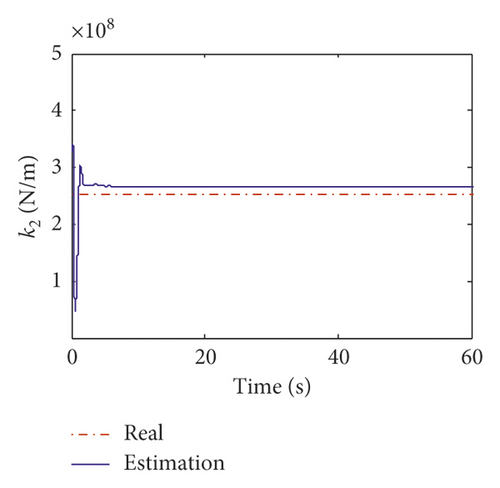
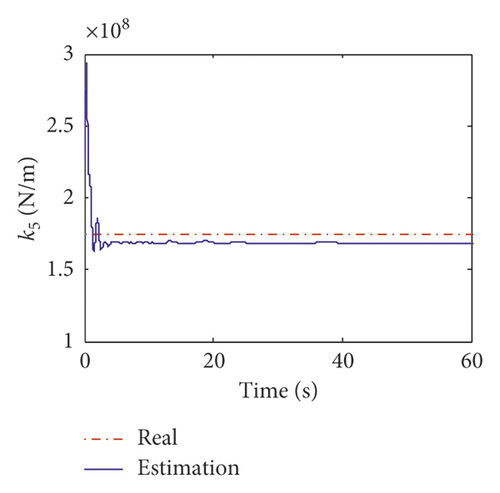

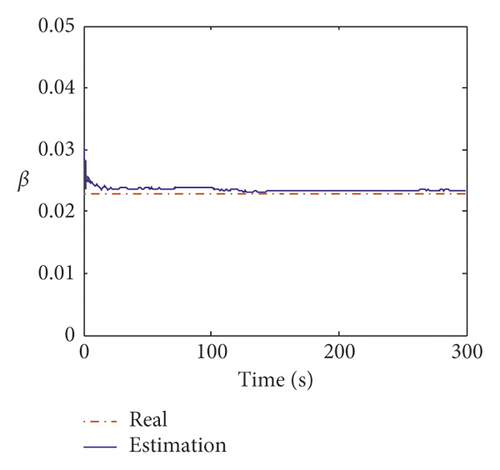
| Structural parameter | True value | Estimated value | Errors (%) |
|---|---|---|---|
| k1 | 9.53 × 108 | 9.02 × 108 | 5.40 |
| k2 | 2.52 × 108 | 2.62 × 108 | 4.25 |
| k3 | 2.30 × 108 | 2.20 × 108 | 4.41 |
| k4 | 2.04 × 108 | 1.94 × 108 | 4.81 |
| k5 | 1.74 × 108 | 1.66 × 108 | 4.52 |
| α | 0.086 | 0.0898 | 3.80 |
| β | 0.023 | 0.0234 | 2.11 |
5. Conclusion
In this paper, a time domain joint state/parameter/wind load estimation method from incomplete measurements is proposed based on modal extended unbiased minimum variance estimation. The recursive procedure includes four parts: time update, modal wind load estimation, measurement update, and coordinate transformation. The measurement responses include the interstory displacement and acceleration responses on partial floors. The estimation quality of the proposed method is numerically validated by simultaneously identifying the structural state, parameters, and wind load of a ten-story shear building structure from incomplete measurements. The effects of crucial factors, including sampling duration and the number of measurements on the convergence and accuracy of the proposed method, are discussed. Moreover, a synchronous multipressure scanning system wind tunnel test on a 234 m tall building structure is used to demonstrate the proposed approach for real structure. A simplified equivalent model with five degrees-of-freedom is derived for experimental validation. Results indicate that the proposed method shows much potential as an alternative way for simultaneously identify the unknown structural parameters, wind load, and wind-induced responses from incomplete measurements.
Conflicts of Interest
The authors declare that there are no conflicts of interest regarding the publication of this article.
Acknowledgments
This work was supported by the National Nature Science Foundation of China (Grant no. 51608153) and Shenzhen Knowledge Innovation Programme (Grant nos. JCYJ20170413105418298, JCYJ20180306171737796, and JCYJ20170811153857358).
Open Research
Data Availability
The data used to support the findings of this study are available from the corresponding author upon request.



